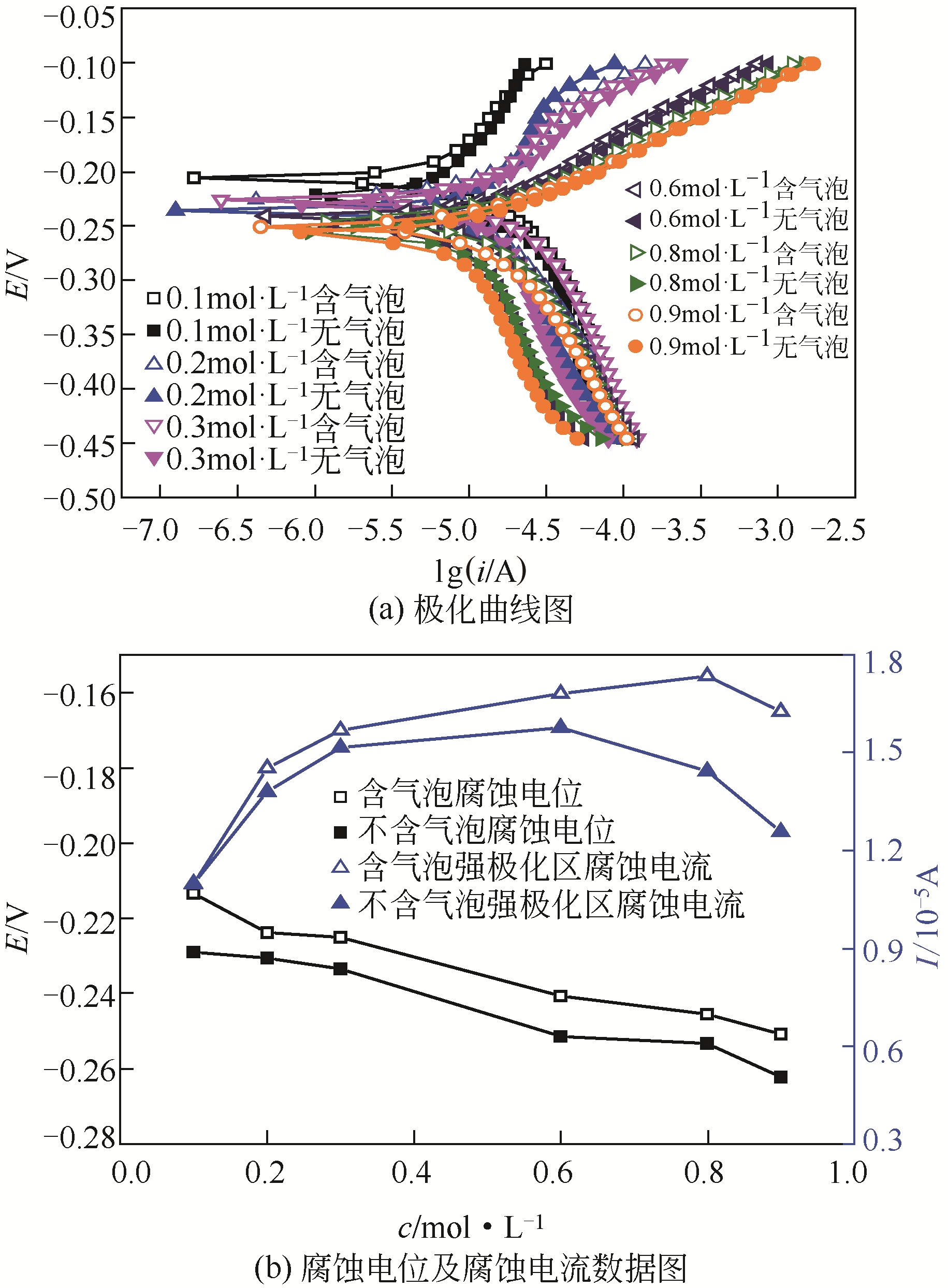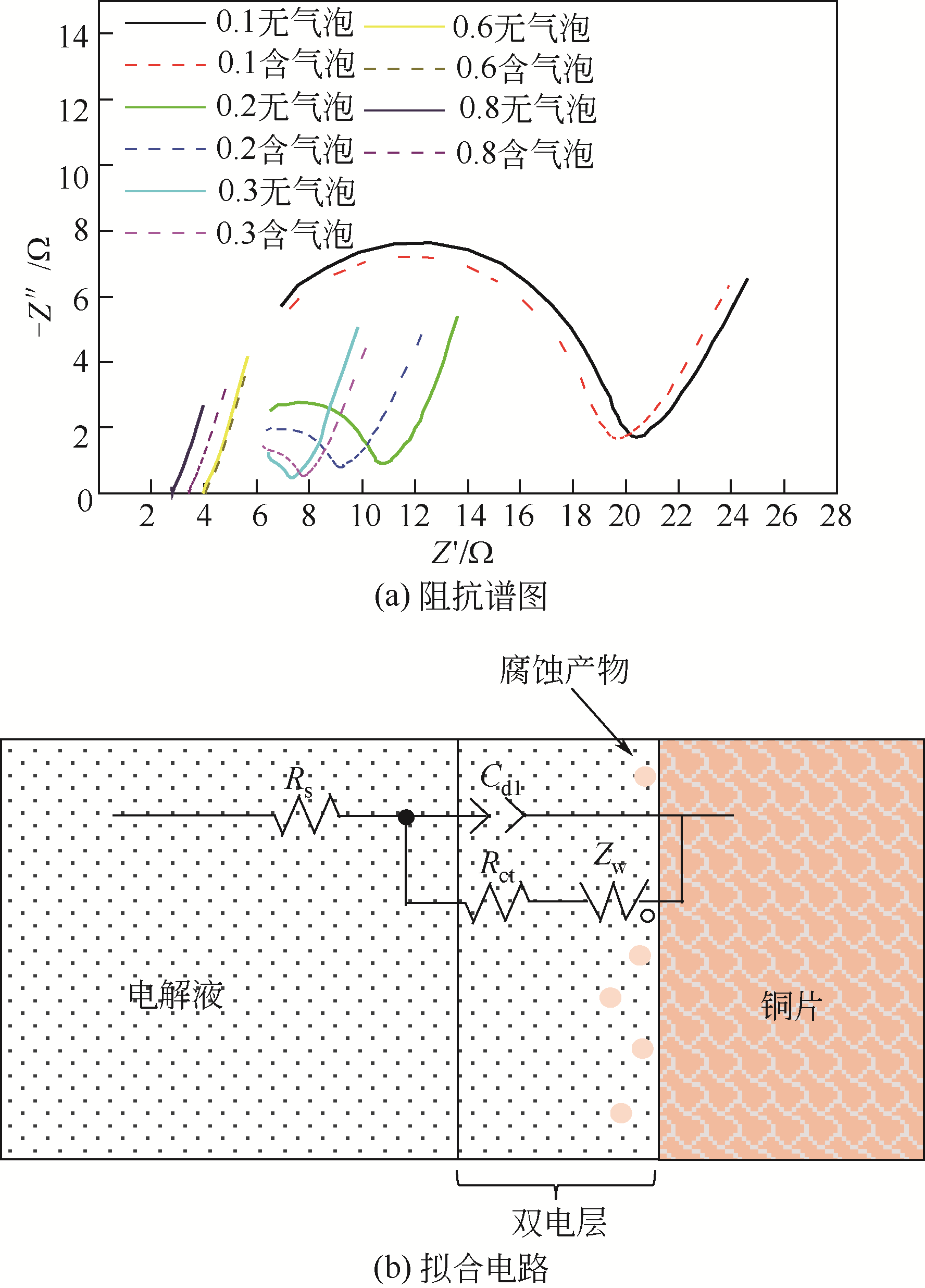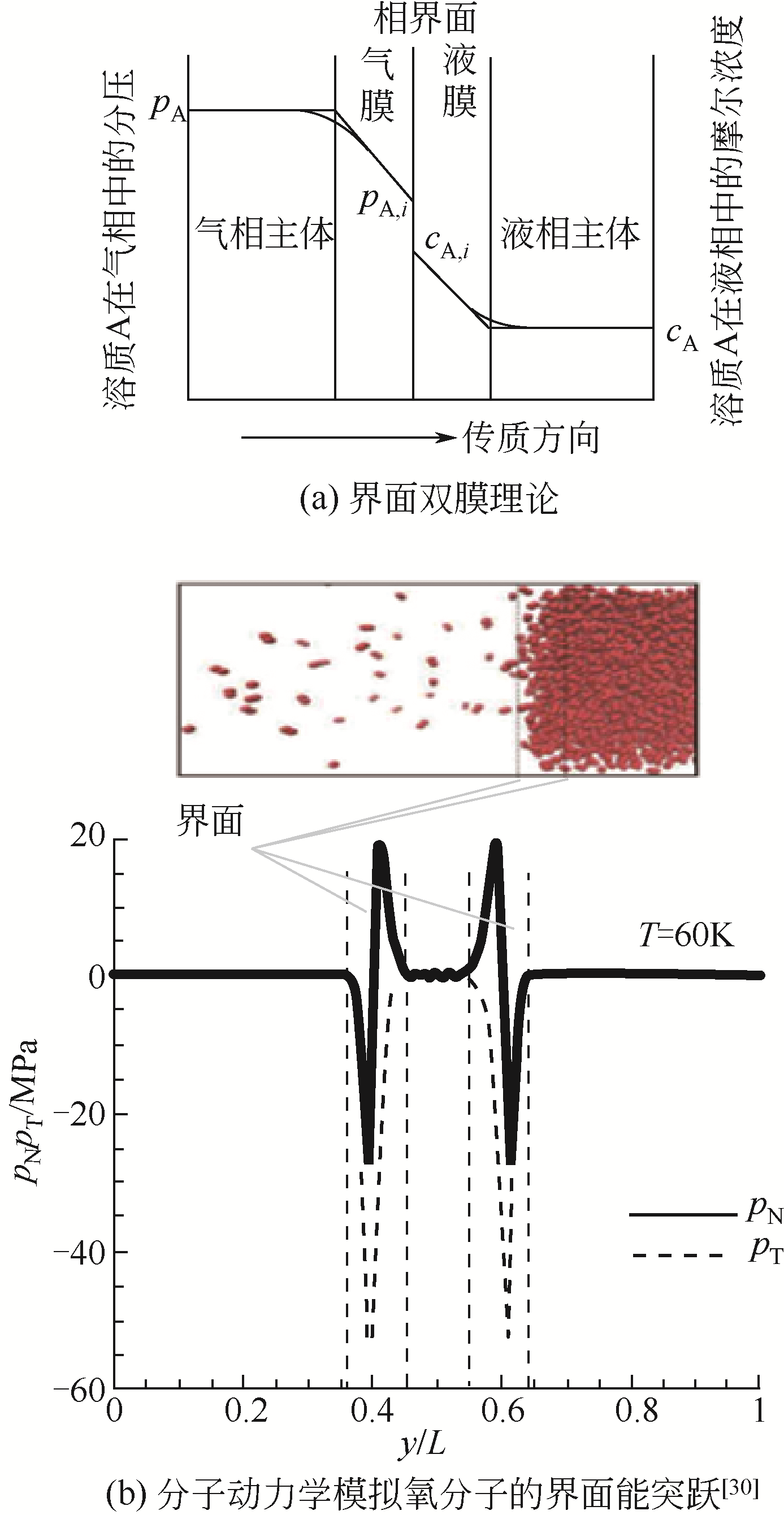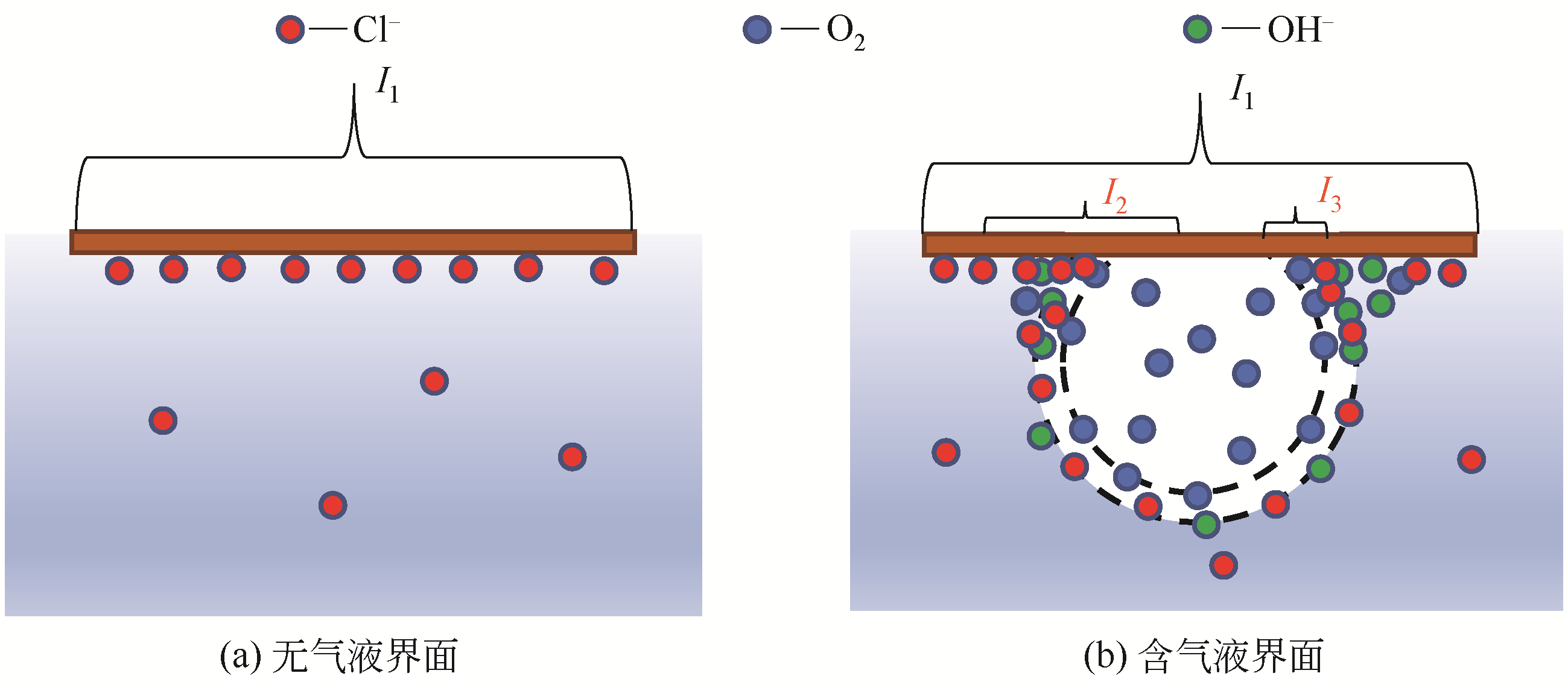Chemical Industry and Engineering Progress ›› 2021, Vol. 40 ›› Issue (3): 1292-1299.DOI: 10.16085/j.issn.1000-6613.2020-0775
• Chemical processes and equipment • Previous Articles Next Articles
Experimental study of the static air-liquid interface corrosion on copper
CHEN Hongxia( ), LIU Lin, LI Linhan
), LIU Lin, LI Linhan
- Energy Power and Mechanical Engineering Department, North China Electric Power University, Beijing 102206, China
-
Received:2020-05-09Online:2021-03-17Published:2021-03-05 -
Contact:CHEN Hongxia
铜基片静态气液界面腐蚀规律的实验
- 华北电力大学能源动力与机械工程学院,北京 102206
-
通讯作者:陈宏霞 -
作者简介:陈宏霞(1980—),女,博士,副教授,研究方向为相变换热及腐蚀。E-mail:hxchen@ncepu.edu.cn 。 -
基金资助:2019年度预研教育部联合基金青年人才基金(6141A02033526);国家自然科学基金(51576063)
CLC Number:
Cite this article
CHEN Hongxia, LIU Lin, LI Linhan. Experimental study of the static air-liquid interface corrosion on copper[J]. Chemical Industry and Engineering Progress, 2021, 40(3): 1292-1299.
陈宏霞, 刘霖, 李林涵. 铜基片静态气液界面腐蚀规律的实验[J]. 化工进展, 2021, 40(3): 1292-1299.
share this article
Add to citation manager EndNote|Ris|BibTeX
URL: https://hgjz.cip.com.cn/EN/10.16085/j.issn.1000-6613.2020-0775
| c/mol·L-1 | ACu/cm2 | Abubble /cm2 | Abubble /ACu |
|---|---|---|---|
| 0.1 | 4 | 0.6483 | 0.1621 |
| 0.2 | 4 | 0.5428 | 0.1357 |
| 0.3 | 4 | 0.7339 | 0.1835 |
| 0.6 | 4 | 0.8992 | 0.2248 |
| 0.8 | 4 | 0.6150 | 0.1537 |
| 0.9 | 4 | 0.6342 | 0.1586 |
| c/mol·L-1 | ACu/cm2 | Abubble /cm2 | Abubble /ACu |
|---|---|---|---|
| 0.1 | 4 | 0.6483 | 0.1621 |
| 0.2 | 4 | 0.5428 | 0.1357 |
| 0.3 | 4 | 0.7339 | 0.1835 |
| 0.6 | 4 | 0.8992 | 0.2248 |
| 0.8 | 4 | 0.6150 | 0.1537 |
| 0.9 | 4 | 0.6342 | 0.1586 |
| c/mol·L-1 | ΔE/V | Iinterface/×10-5A | V/mm·a-1 |
|---|---|---|---|
| 0.1 | 0.0156 | 0.1964 | 2.2911 |
| 0.2 | 0.0068 | 0.2594 | 3.0260 |
| 0.3 | 0.0084 | 0.3309 | 3.8601 |
| 0.6 | 0.0107 | 0.4586 | 5.3498 |
| 0.8 | 0.0078 | 0.5132 | 5.9867 |
| 0.9 | 0.0114 | 0.5687 | 6.6341 |
| c/mol·L-1 | ΔE/V | Iinterface/×10-5A | V/mm·a-1 |
|---|---|---|---|
| 0.1 | 0.0156 | 0.1964 | 2.2911 |
| 0.2 | 0.0068 | 0.2594 | 3.0260 |
| 0.3 | 0.0084 | 0.3309 | 3.8601 |
| 0.6 | 0.0107 | 0.4586 | 5.3498 |
| 0.8 | 0.0078 | 0.5132 | 5.9867 |
| 0.9 | 0.0114 | 0.5687 | 6.6341 |
| 浓度/mol?L-1 | 有无相界面 | Rs/Ω·cm-2 | Rct /Ω·cm-2 | Cdl/F·cm-2 | β(弥散系数) | Zw/Ω·cm-2 | 方差值 |
|---|---|---|---|---|---|---|---|
| 0.1 | 含界面 | 4.267 | 13.67 | 2.226×10-8 | 1.002 | 5.747 | 0.00011358 |
| 无界面 | 4.14 | 14.57 | 2.3001×10-8 | 1.001 | 4.401 | 0.00005130 | |
| 0.2 | 含界面 | 4.631 | 3.722 | 5.9544×10-8 | 0.98897 | 3.806 | 0.00026404 |
| 无界面 | 4.57 | 5.379 | 5.4566×10-8 | 0.9853 | 4.232 | 0.00020466 | |
| 0.3 | 含界面 | 4.426 | 2.831 | 9.6633×10-8 | 0.95495 | 2.503 | 0.00022757 |
| 无界面 | 4.15 | 2.657 | 8.9033×10-8 | 0.98519 | 2.86 | 0.00032575 |
| 浓度/mol?L-1 | 有无相界面 | Rs/Ω·cm-2 | Rct /Ω·cm-2 | Cdl/F·cm-2 | β(弥散系数) | Zw/Ω·cm-2 | 方差值 |
|---|---|---|---|---|---|---|---|
| 0.1 | 含界面 | 4.267 | 13.67 | 2.226×10-8 | 1.002 | 5.747 | 0.00011358 |
| 无界面 | 4.14 | 14.57 | 2.3001×10-8 | 1.001 | 4.401 | 0.00005130 | |
| 0.2 | 含界面 | 4.631 | 3.722 | 5.9544×10-8 | 0.98897 | 3.806 | 0.00026404 |
| 无界面 | 4.57 | 5.379 | 5.4566×10-8 | 0.9853 | 4.232 | 0.00020466 | |
| 0.3 | 含界面 | 4.426 | 2.831 | 9.6633×10-8 | 0.95495 | 2.503 | 0.00022757 |
| 无界面 | 4.15 | 2.657 | 8.9033×10-8 | 0.98519 | 2.86 | 0.00032575 |
| 1 | 周威, 花飞, 龚朝兵, 等.污水汽提装置富氨气系统腐蚀原因及对策[J]. 石油化工腐蚀与防护, 2013(1): 40-43. |
| ZHOU W, HUA F, GONG C B, et al. Causes of corrosion of ammonia-rich gas system in sewage stripping unit and countermeasures[J]. Corrosion and Protectionin Petrochemical Industry, 2013(1): 40-43. | |
| 2 | LUCKOW P, BAR-COHEN A, RODGERS P, et al. Energy efficient polymers for gas-liquid heat exchangers[J]. Journal of Energy Resources Technology, 2010, 132(2): 021001-021009. |
| 3 | DAS G, CHOWDHURY S G, RAY A K, et al. Turbine blade failure in a thermal power plant[J]. Engineering Failure Analysis, 2003, 10(1): 85-91. |
| 4 | 郑云萍, 刘奇, 张峰, 等.气井井下的腐蚀监测技术[J].腐蚀与防护, 2013, 34(4): 355-358. |
| ZHENG Y P, LIU Q, ZHANG F, et al. Downhole corrosion monitoring technology of gas well[J]. Corrosion and Protection, 2013, 34(4): 355-358. | |
| 5 | OSSAI C I, BEREKET G, GU C, et al. Advances in asset management techniques: an overview of corrosion mechanisms and mitigation strategies for oil and gas pipelines[J].International Scholarly Research Notices Corrosion, 2012, 2012: 570143. |
| 6 | SOYAMA H. Corrosion behavior of pressure vessel steel exposed to residual bubbles after cavitation bubble collapse[J]. Corrosion, 2011, 67(2): 1-8. |
| 7 | LUO S Z, ZHENG Y G, LI M C, et al. Effect of cavitation on corrosion behavior of 20SiMn low-alloy steel in 3% sodium chloride solution[J]. Corrosion, 2003, 59(7): 597-605. |
| 8 | YONG X, HOU C, WU J J, et al. Cavitation corrosion of anodized aluminum alloy in 3.5% NaCl solution[J]. Corrosion, 2011, 67(4): 450031-450036. |
| 9 | 陈亚林, 张伟, 王伟, 等. WBE技术研究水线区Q235碳钢腐蚀[J]. 中国腐蚀与防护学报, 2014, 34(5): 451-458. |
| CHEN Y L, ZHANG W, WANG W, et al. Evaluation of water-line area corrosion for Q235 steel by WBE technique[J]. Journal of Chinese Society for Corrosion and Protection, 2014, 34(5): 451-458. | |
| 10 | 邢佩, 卢琳, 李晓刚.丝束电极技术研究海洋高强用E690钢水线腐蚀[C]//中国腐蚀与防护学会, 北京: 北京丰盈环蚀技术有限公司, 2015: 2-6, 9. |
| XING P, LU L, LI X G. Study on water line corrosion of E690 ocean platform steels using WBE technique[C]//Chinese Society for Corrosion and Protection, Beijing, China: Beijing Fengying Ring Corrosion Technology Company, 2015: 2-6, 9. | |
| 11 | LI X J, CONG H B, GUI F, et al. Development of liquid-air-interface corrosion of steel in nitrate solutions[J]. Corrosion, 2014, 70(3): 230-246. |
| 12 | EBARA R, TANAKA F, KAWASAKI M. Sulfuric acid dew pointcorrosion in waste heat boiler tube for copper smelting furnace[J].Engineering Failure Analysis, 2013, 33: 29-36. |
| 13 | DING Q, TANG X F, YANG Z G. Failure analysis on abnormalcorrosion of economizer tubes in a waste heat boiler[J]. Engineering Failure Analysis, 2017, 73: 129-138. |
| 14 | GOU W, ZHANG H, LI H, et al. Effects of silica sand on synergistic erosion caused by cavitation abrasion and corrosion[J]. Wear, 2018, 412: 120-126. |
| 15 | 朱道峰, 宋玉, 陈小平, 等.腐蚀垢层对海洋天然气管道CO2腐蚀过程的影响[J]. 腐蚀与防护, 2019, 40(9): 633-637. |
| ZHU D F, SONG Y, CHEN X P, et al. Influence of corrosion scale on CO2 corrosion of marine gas pipeline[J]. Corrosion and Protection, 2019, 40(9): 633-637. | |
| 16 | ZHANG Z, WANG Z, LIU H, et al. Experimental study on bubble and droplet entrainment in vertical churn and annular flows and their relationship[J]. Chemical Engineering Science, 2019, 206: 387-400. |
| 17 | CHEN Y, ZHANG W, DING J, et al. Research on water-line corrosion of carbon steel by wire beam electrode technique[C]//EDP Sciences, MATEC Web of Conferences, Wuhan, 2016: 14-19. |
| 18 | LI S X, TEAGUE M T, DOLL G L, et al. Interfacial corrosion of copper in concentrated chloride solution and the formation of copper hydroxychloride[J]. Corrosion Science, 2018, 141: 243-254. |
| 19 | LIU X Q, LIU Z L, HU J D, et al. Influence of Cr content on corrosion behaviour of tube pile steel in half-immersion environment[J].Transactions of the Indian Institute of Metals, 2018, 71(1): 209-218. |
| 20 | REFAIT P, GROLLEAU A M, JEANNIN M, et al. Corrosion of mild steel at the seawater/sediments interface: mechanisms and kinetics[J].Corrosion Science, 2018, 130: 76-84. |
| 21 | XU W, ZHANG B, YANG L, et al. Liquid-air interface corrosion of A537 steel in high level liquid radioactive waste simulant in a sealed container[J]. Journal of the Electrochemical Society, 2019, 166(2): 33-41. |
| 22 | WEI W, SUN F, SHI Y, et al. Theoretical prediction of acid dew point and safe operating temperature of heat exchangers for coal-fired power plants[J]. Applied Thermal Engineering, 2017, 123: 782-790. |
| 23 | ISLAM M, POJTANABUNTOENG T, GUBNER R. Condensation corrosion of carbon steel at low to moderate surface temperature and iron carbonate precipitation kinetics[J]. Corrosion Science, 2016, 111: 139-150. |
| 24 | FENG J K. Principle and calculation of the boiler[M]. Beijing: Science Press, 2003: 371-379. |
| 25 | LI X, WU Z, ZHANG L, et al. An updated acid dew point temperature estimation method for air-firing and oxy-fuel combustion processes[J].Fuel Processing Technology, 2016, 154: 204-209. |
| 26 | 陈衡, 潘佩媛, 赵钦新, 等. 燃煤工业锅炉黏性积灰和露点腐蚀耦合机理[J]. 化工学报, 2017, 68(12): 4774-4783. |
| CHEN H, PAN P Y, ZHAO Q X, et al. Coupling mechanism of viscose ash deposition and dew point corrosion in industrial coal-fired boiler[J]. CIESC Journal, 2017, 68(12): 4774-4783. | |
| 27 | 林翠, 肖志阳. 碳钢在NaCl薄液膜下的电化学腐蚀行为[J].腐蚀与防护, 2014, 35(4): 316-320. |
| LIN C, XIAO Z Y. Electrochemical corrosion behavior of carbon steel under thin electrolyte layer containing NaCl[J]. Corrosion and Protection, 2014, 35(4): 316-320. | |
| 28 | 张雪. 利用阵列电极研究水线腐蚀的机理[D]. 青岛: 中国海洋大学, 2013. |
| ZHANG X. Study on the mechanism of carbon steel under water-line with wire beam electrode method[D]. Qingdao: Ocean University of China, 2013. | |
| 29 | 胡杰珍. 海洋环境跃变区碳钢腐蚀行为与机理研究[D].北京: 北京科技大学, 2016. |
| HU J Z. Research of the corrosion behavior and mechanism of metal in the juncture area of marine environment[D]. Beijing: University of Science and Technology Beijing, 2016. | |
| 30 | 马友光, 余国琮. 气液相际传质的理论研究[J].天津大学学报, 1998, 31(4): 506-510. |
| MA Y G, YU G Z. Thetheoretical studies of interphase mass transfer[J]. Journal of the Tianjin University, 1998, 31(4): 506-510. | |
| 31 | 毛志红. 气液界面特性的分子动力学模拟研究[D].杭州: 中国计量学院, 2014. |
| MAO Z H. Characteristics of gas-liquid interface using molecular dynamics simulation[D]. Hangzhou: China Jiliang University, 2014. | |
| 32 | 翁永基, 赵海燕. 用丝束电极(WBE)评价不锈钢在NaCl溶液中点蚀敏感性[J]. 中国腐蚀与防护学报, 2003, 23(6): 326-329. |
| WENG Y J, ZHAO H Y. Evaluation of pitting sensitivity of stainless steel in NaCl solutions by means of wire beam electrodes (WBE)[J]. Journal of Chinese Society for Corrosion and Protection, 2003, 23(6): 326-329. | |
| 33 | 王志武, 原素芳. 黄铜腐蚀速度与Cl-浓度的关系[J].材料保护, 2004(10): 50-51, 66. |
| WANG Z W, YUAN S F. Relation between corrosion rate of brass and concentration of chloridion[J]. Journal of Materials Protection, 2004(10): 50-51, 66. |
| [1] | GU Yongzheng, ZHANG Yongsheng. Dynamic behavior and kinetic model of Hg0 adsorption by HBr-modified fly ash [J]. Chemical Industry and Engineering Progress, 2023, 42(S1): 498-509. |
| [2] | ZHANG Jie, BAI Zhongbo, FENG Baoxin, PENG Xiaolin, REN Weiwei, ZHANG Jingli, LIU Eryong. Effect of PEG and its compound additives on post-treatment of electrolytic copper foils [J]. Chemical Industry and Engineering Progress, 2023, 42(S1): 374-381. |
| [3] | HU Xi, WANG Mingshan, LI Enzhi, HUANG Siming, CHEN Junchen, GUO Bingshu, YU Bo, MA Zhiyuan, LI Xing. Research progress on preparation and sodium storage properties of tungsten disulfide composites [J]. Chemical Industry and Engineering Progress, 2023, 42(S1): 344-355. |
| [4] | ZHANG Mingyan, LIU Yan, ZHANG Xueting, LIU Yake, LI Congju, ZHANG Xiuling. Research progress of non-noble metal bifunctional catalysts in zinc-air batteries [J]. Chemical Industry and Engineering Progress, 2023, 42(S1): 276-286. |
| [5] | YANG Yudi, LI Wentao, QIAN Yongkang, HUI Junhong. Analysis of influencing factors of natural gas turbulent diffusion flame length in industrial combustion chamber [J]. Chemical Industry and Engineering Progress, 2023, 42(S1): 267-275. |
| [6] | WANG Yaogang, HAN Zishan, GAO Jiachen, WANG Xinyu, LI Siqi, YANG Quanhong, WENG Zhe. Strategies for regulating product selectivity of copper-based catalysts in electrochemical CO2 reduction [J]. Chemical Industry and Engineering Progress, 2023, 42(8): 4043-4057. |
| [7] | LIU Yi, FANG Qiang, ZHONG Dazhong, ZHAO Qiang, LI Jinping. Cu facets regulation of Ag/Cu coupled catalysts for electrocatalytic reduction of carbon dioxide [J]. Chemical Industry and Engineering Progress, 2023, 42(8): 4136-4142. |
| [8] | ZHANG Yajuan, XU Hui, HU Bei, SHI Xingwei. Preparation of NiCoP/rGO/NF electrocatalyst by eletroless plating for efficient hydrogen evolution reaction [J]. Chemical Industry and Engineering Progress, 2023, 42(8): 4275-4282. |
| [9] | WANG Shuaiqing, YANG Siwen, LI Na, SUN Zhanying, AN Haoran. Research progress on element doped biomass carbon materials for electrochemical energy storage [J]. Chemical Industry and Engineering Progress, 2023, 42(8): 4296-4306. |
| [10] | LI Haidong, YANG Yuankun, GUO Shushu, WANG Benjin, YUE Tingting, FU Kaibin, WANG Zhe, HE Shouqin, YAO Jun, CHEN Shu. Effect of carbonization and calcination temperature on As(Ⅲ) removal performance of plant-based Fe-C microelectrolytic materials [J]. Chemical Industry and Engineering Progress, 2023, 42(7): 3652-3663. |
| [11] | XU Wei, LI Kaijun, SONG Linye, ZHANG Xinghui, YAO Shunhua. Research progress of photocatalysis and co-electrochemical degradation of VOCs [J]. Chemical Industry and Engineering Progress, 2023, 42(7): 3520-3531. |
| [12] | ZHAO Yi, YANG Zhen, ZHANG Xinwei, WANG Gang, YANG Xuan. Molecular simulation of self-healing behavior of asphalt under different crack damage and healing temperature [J]. Chemical Industry and Engineering Progress, 2023, 42(6): 3147-3156. |
| [13] | LU Shijian, ZHANG Yuanyuan, WU Wenhua, YANG Fei, LIU Ling, KANG Guojun, LI Qingfang, CHEN Hongfu, WANG Ning, WANG Feng, ZHANG Juanjuan. Health risk assessment of nitrosamine pollutant diffusion in a million ton CO2 capture project [J]. Chemical Industry and Engineering Progress, 2023, 42(6): 3209-3216. |
| [14] | ZHANG Peng, PAN Yuan. Progress of single atom catalysts in electrocatalytic oxygen reduction to hydrogen peroxide [J]. Chemical Industry and Engineering Progress, 2023, 42(6): 2944-2953. |
| [15] | CHEN Shaohua, WANG Yihua, HU Qiangfei, HU Kun, CHEN Li’ai, LI Jie. Research progress on detection of Cr(Ⅵ) by electrochemically modified electrode [J]. Chemical Industry and Engineering Progress, 2023, 42(5): 2429-2438. |
| Viewed | ||||||
|
Full text |
|
|||||
|
Abstract |
|
|||||






